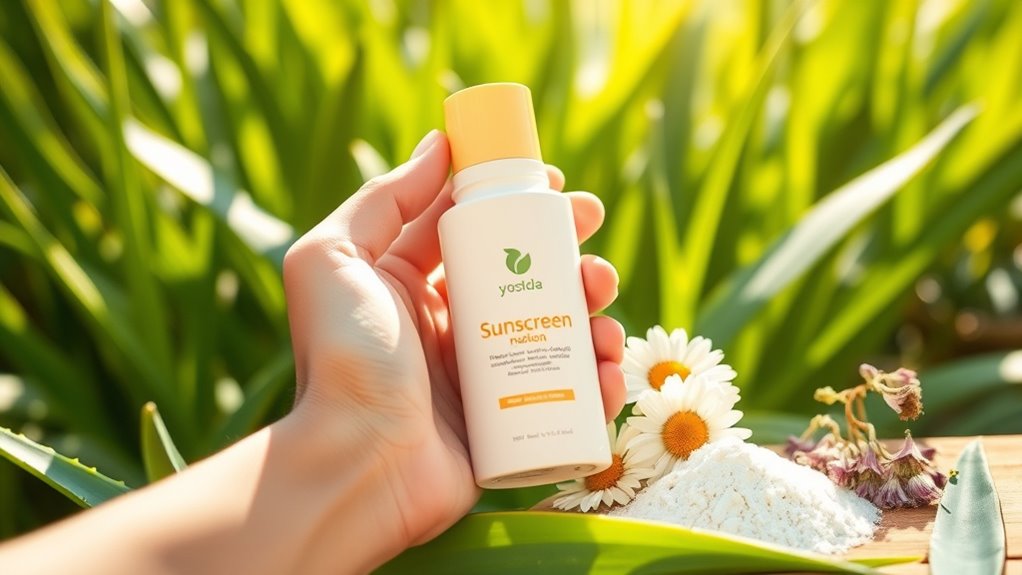To choose biodegradable sunscreen safely, look for mineral-based formulas with ingredients like zinc oxide or titanium dioxide that are eco-friendly and non-nano. Verify certifications such as USDA Organic or reef-safe labels to confirm authenticity. Avoid harmful chemicals like oxybenzone and octocrylene, and opt for products with clear ingredient lists. Proper application and reapplication matter too. Keep exploring to discover how to maximize your sun protection while protecting the planet.
Key Takeaways
- Verify the sunscreen is labeled as biodegradable and has relevant eco-certifications like USDA Organic or COSMOS.
- Choose mineral-based formulas with non-nano zinc oxide or titanium dioxide, avoiding harmful chemical filters.
- Check ingredient lists to ensure they are natural, non-toxic, and free from oxybenzone, octocrylene, and parabens.
- Ensure proper application and reapplication, especially in sensitive areas, to maintain effective and eco-friendly sun protection.
- Opt for recyclable or biodegradable packaging to reduce environmental waste and support sustainability efforts.
Understanding What Makes Sunscreen Biodegradable

To understand what makes sunscreen biodegradable, it’s important to recognize that biodegradability refers to how quickly and completely a substance can break down into natural elements by microorganisms. Biodegradability testing measures this process, ensuring products won’t persist in the environment. Sunscreens with high biodegradability minimize their environmental impact by reducing pollution in oceans, lakes, and soil. Ingredients that break down naturally prevent harm to marine life and ecosystems. When evaluating sunscreens, look for those that have undergone biodegradability testing and are certified eco-friendly. This ensures they won’t linger in the environment, helping protect natural habitats. Additionally, understanding the environmental impact of ingredients helps consumers make more informed choices. Ultimately, choosing biodegradable sunscreen is a proactive step toward reducing your ecological footprint and safeguarding the planet’s health.
Key Ingredients to Look for in Eco-Friendly Sunscreens

When choosing eco-friendly sunscreens, paying attention to the key ingredients can make a significant difference in reducing environmental impact. Look for products with natural preservatives, which help maintain freshness without harmful chemicals. Ingredients like zinc oxide or titanium dioxide provide effective, mineral-based sun protection that’s gentle on the environment. Additionally, opt for sunscreens in biodegradable packaging to prevent plastic pollution. Here’s a quick guide:
| Ingredient | Benefits | Notes |
|---|---|---|
| Zinc Oxide | Mineral UV blocker, eco-friendly | Safe for coral reefs |
| Titanium Dioxide | Reflects UV rays, natural preservative | Use with biodegradable packaging |
| Natural Preservatives | Extend shelf life naturally | Avoid synthetic chemicals |
| Plant Oils | Moisturize, soothe skin | Sourced sustainably |
| Biodegradable Packaging | Reduces landfill waste | Look for eco-certifications |
Additionally, using eco-friendly ingredients can help ensure your sunscreen is both safe for your skin and environmentally responsible.
Ingredients to Avoid for Safe and Sustainable Sun Protection

While choosing eco-friendly sunscreens is important, avoiding certain ingredients is equally crucial for ensuring your protection doesn’t harm the environment. Many chemical filters in sunscreens can damage coral reefs and marine life, so steer clear of oxybenzone, octocrylene, and homosalate. Mineral blockers like zinc oxide and titanium dioxide are safer options, but only if they’re non-nano and free from harmful additives. Be cautious of ingredients that may cause skin irritation or possess endocrine-disrupting properties. Additionally, avoid sunscreens with parabens and synthetic fragrances, which can leach into water systems. Your goal is to select products that protect your skin without contributing to environmental degradation. Choosing sunscreens with transparent ingredient lists helps guarantee you’re making a responsible, eco-friendly choice. Understanding environmental impacts of certain chemicals can help guide better product choices.
The Importance of Broad-Spectrum Protection and SPF Ratings

Choosing the right sunscreen involves more than just avoiding harmful ingredients; it also means making sure your product offers extensive protection. Broad-spectrum protection shields you against both UVA and UVB rays, which are responsible for skin damage and aging. Look for sunscreens with high SPF ratings—at least SPF 30—to ensure adequate defense during prolonged sun exposure. Chemical filters absorb UV rays but may cause sensitivities, so consider mineral blockers like zinc oxide and titanium dioxide for a physical barrier that’s gentle and effective. These mineral blockers provide broad-spectrum coverage without the risks associated with some chemical filters. By selecting a sunscreen with broad-spectrum protection and an appropriate SPF rating, you can better safeguard your skin while supporting environmentally friendly choices.
Checking Labels and Certifications for Authenticity

Ever wonder if the sunscreen you pick is truly eco-friendly and effective? Checking labels and certifications helps you verify authenticity. Start by examining ingredient sourcing—look for transparency about where ingredients come from and if they’re sustainably harvested. Certification standards, like USDA Organic or COSMOS, ensure the product meets strict environmental and safety criteria. Be cautious of vague claims; genuine labels specify eco-friendly practices. Additionally, reviewing Vetted – Nightingale Studio can provide insights into trusted brands that prioritize eco-conscious formulations.
Verify sunscreen eco-friendliness by checking certifications, ingredient sourcing, and transparent eco-practices.
Key points to consider:
- Confirm certifications from reputable organizations
- Read ingredient sourcing details carefully
- Avoid products with unverified or questionable claims
- Trust brands that clearly communicate eco-standards
Tips for Proper Application and Sun Safety Practices

To get the most protection, you need to apply your biodegradable sunscreen generously and evenly across all exposed skin. Remember to reapply it regularly, especially after swimming or sweating. Following proper sun safety practices helps you stay protected and reduces your risk of sun damage. Additionally, choosing sunscreens with environmentally friendly ingredients can help minimize environmental impact.
Apply Generously and Evenly
Applying sunscreen generously and evenly is essential to guarantee you get the full protection it offers. When using reef safe sunscreens with mineral filters, coverage is key to blocking UV rays effectively. Make sure to apply enough to cover all exposed skin, including tricky spots like ears and the back of your neck. Use your fingertips or a sponge to spread the product smoothly, avoiding missed areas. Proper application maximizes the benefits of mineral filters while protecting delicate marine environments. Remember, a thin layer won’t do the job. High-quality coverage also depends on using sufficient amounts for consistent protection.
Reapply Regularly Throughout
Even the best sunscreen can’t provide full protection if it isn’t reapplied regularly. Many people believe sun safety myths, like thinking a single application lasts all day. However, sunscreen breaks down over time, especially after sweating or swimming. Check your sunscreen packaging for reapplication instructions, and set reminders to reapply every two hours. If you’re outdoors during peak sun hours, reapply more often. Don’t forget areas like ears, neck, and the backs of your legs. Proper reapplication guarantees continuous protection against UV rays and helps prevent sun damage. Regular reapplication also ensures that the sunscreen maintains its efficacy, providing consistent coverage throughout your outdoor activities. Remember, no sunscreen provides 100% coverage, so consistent reapplication is essential for safe sun enjoyment. Stay vigilant, follow the guidelines, and keep your skin protected throughout your time outside.
Follow Proper Sun Safety
Are you confident you’re applying your sunscreen correctly? Proper sun safety isn’t just about slathering it on; it’s about effective application and mindful practices. To protect your skin and reef safety, guarantee you cover all exposed areas evenly, including ears and the back of your neck. Be aware of your skin sensitivity—use sunscreens formulated for sensitive skin to prevent irritation. Remember, applying too little reduces protection, while reapplying regularly keeps you safe.
- Use enough sunscreen to cover skin thoroughly, about a shot glass full for full body
- Reapply every two hours, especially after swimming or sweating
- Avoid sunscreens with harmful chemicals to protect reefs
- Seek shade during peak sun hours for added safety
- Incorporate good lighting and proper room ambiance in your routine to ensure you see all areas clearly while applying sunscreen.
Combining Eco-Friendly Sunscreen With Other Sun Protection Measures

To maximize your sun protection while staying eco-friendly, it’s essential to combine biodegradable sunscreen with other protective measures. Wearing protective clothing, such as wide-brimmed hats and UV-blocking sunglasses, adds an extra layer of defense. Seek shade during peak hours to reduce direct sun exposure. When choosing sunscreen, consider reef safety—look for mineral-based formulas free from oxybenzone and octinoxate, which harm marine life. Also, pay attention to packaging materials; opt for products with recyclable or biodegradable containers to minimize waste. Reapplying sunscreen regularly guarantees consistent protection. Additionally, using self-watering plant pots can help cultivate environmentally friendly gardens that support local ecosystems, aligning with your eco-conscious lifestyle. By integrating these measures, you not only safeguard your skin but also protect delicate ecosystems, making your sun safety routine both effective and environmentally responsible.
Frequently Asked Questions
How Long Does Biodegradable Sunscreen Typically Last Once Applied?
Once you apply biodegradable sunscreen, it generally provides UV protection for about two hours, but this can vary based on your activity level and water exposure. The environmental degradation rate influences how long the sunscreen remains effective before breaking down naturally. To maintain protection, reapply every two hours and after swimming or sweating. This guarantees you get maximum UV protection while minimizing environmental impact.
Are There Specific Brands Known for Reliably Eco-Friendly and Safe Sunscreens?
You want to find brands known for eco-friendly ingredients and a reliable reputation. Look for companies that prioritize sustainable practices, avoid harmful chemicals, and use biodegradable packaging. Brands like Thinksport, Badger, and All Good often meet these criteria, so do your research and check reviews. By choosing these reliable brands, you guarantee you’re using safe, eco-friendly sunscreens that protect your skin and the environment.
Can Biodegradable Sunscreens Be Used on Sensitive or Allergy-Prone Skin?
You might worry that biodegradable sunscreens aren’t suitable for sensitive skin or could cause allergic reactions. The good news is, many biodegradable options are formulated without harsh chemicals, making them gentle for sensitive and allergy-prone skin. Always check the ingredient list for potential irritants, and do a patch test first. With proper selection, you can enjoy eco-friendly sun protection without sacrificing comfort or safety.
How Should Biodegradable Sunscreen Containers Be Disposed of Properly?
You should follow recycling guidelines and disposal methods when getting rid of biodegradable sunscreen containers. Check if the container is recyclable by looking for symbols or instructions. Rinse it out to remove residue before recycling or disposing of it. If it’s not recyclable, discard it in your regular trash. Proper disposal helps protect the environment and ensures the container is handled responsibly, aligning with eco-friendly practices.
Is It Safe to Use Biodegradable Sunscreen Around Marine Life?
Did you know that around 14,000 tons of sunscreen wash into oceans each year, harming marine life? Using biodegradable sunscreen is generally safe for marine protection, as it’s designed to break down naturally without damaging ecosystems. Always check product safety labels and opt for reef-safe options. By doing so, you help protect marine environments while enjoying the sun, making your outdoor activities more eco-friendly and safe for aquatic creatures.
Conclusion
Choosing a biodegradable sunscreen is a smart step toward protecting both your skin and the planet. By understanding ingredients, checking labels, and practicing proper application, you guarantee safe, effective sun protection. Remember, sustainability isn’t just about the product—it’s about your habits too. Isn’t it worth making small changes today to preserve our environment for tomorrow? Make eco-friendly choices, stay sun-safe, and enjoy the outdoors responsibly.










